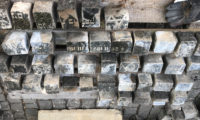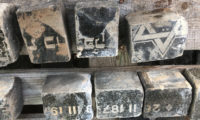 Redevelopment of Prague’s historic downtown has revealed dozens of paving stones made from desecrated Jewish headstones. Wenceslas Square, the site of massive popular demonstrations during the Velvet Revolution of 1989, is one of two main squares in Prague and the heart of the city’s nightlife. As part of a revamp of the tourist district, the cobblestones paving its long rectangular expanse were raised. They were installed in the 1980s when the former Czechoslovakia was under Communist rule. At that time, Leo Pavlat, the current director of Jewish Museum in Prague, found two paving stones with Jewish markings. When the plans to revamp the square became known, Pavlat’s recollections spurred the city council to allow observers from the Jewish community to survey the work on Wenceslas Square.
Redevelopment of Prague’s historic downtown has revealed dozens of paving stones made from desecrated Jewish headstones. Wenceslas Square, the site of massive popular demonstrations during the Velvet Revolution of 1989, is one of two main squares in Prague and the heart of the city’s nightlife. As part of a revamp of the tourist district, the cobblestones paving its long rectangular expanse were raised. They were installed in the 1980s when the former Czechoslovakia was under Communist rule. At that time, Leo Pavlat, the current director of Jewish Museum in Prague, found two paving stones with Jewish markings. When the plans to revamp the square became known, Pavlat’s recollections spurred the city council to allow observers from the Jewish community to survey the work on Wenceslas Square.
 Rabbi Chaim Kočí, a senior official with the Prague rabbinate, witnessed workers unearthing cobblestones whose undersides revealed Hebrew lettering, the star of David and deceased dates. Other stones were blank but had polished surfaces that indicated they had also been taken from cemeteries.
Rabbi Chaim Kočí, a senior official with the Prague rabbinate, witnessed workers unearthing cobblestones whose undersides revealed Hebrew lettering, the star of David and deceased dates. Other stones were blank but had polished surfaces that indicated they had also been taken from cemeteries.
Jewish leaders hailed the unearthing as proof of long-held suspicions that the communist authorities – who ruled the former Czechoslovakia for more than four decades during the cold war – had taken stonework from Jewish burial sites for a much-vaunted pedestrianisation of Wenceslas Square during the 1980s.
“We feel this is a victory for us because until now this was just a rumour. Maybe there were Jewish stones here, but nobody knew,” said Kočí, who had been at Wenceslas Square since early morning to witness the stones being dug up. “It’s important because it’s a matter of truth.
“We are making something right for the historical record. These are stones from the graves of people who were dead for maybe 100 years and now they are lying here. It’s not nice.”
Only small segments of the headstone markings can be seen because they were broken down into cubes. There are dates, Hebrew letters and stars of David visible, but no full names. The oldest visible date is 1877, the most recent is the 1970s. They were stolen from different cemeteries.
Synagogues and cemeteries were allowed to fall into disrepair under an officially sanctioned hostile policy towards religious institutions in general and Judaism in particular, making them vulnerable to looting.
František Bányai, the chairman of Prague’s Jewish community, said the discovery made him angry at the communist regime.
“More Jewish synagogues were destroyed in the area of the current Czech Republic during communist times than under the Nazis,” he said. “It was because of their special approach to religion. Anti-Judaism was official policy and all the Jewish committees were supervised and managed by control of the secret police. To be Jewish was negative from any point of view – but it was the same for the Christian church.”